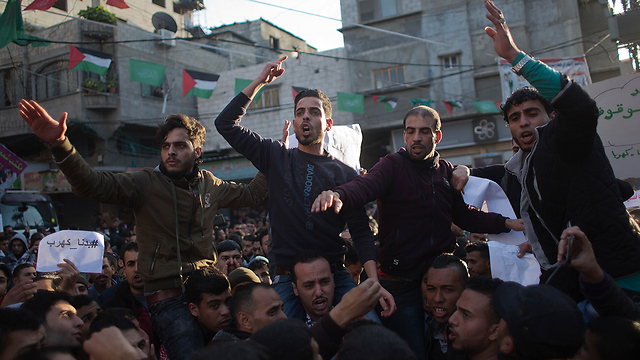Analysis: The Palestinians on the Gaza street no longer believe that their living conditions will ever improve. The fiery protests of the past few days are an uprising in the making and have exposed, for the first time, the potential of toppling the Hamas government from the inside.
When thousands of members of “The Young” movement marched last Thursday on the streets of Jabalia in the Gaza Strip, chanting the battle cry of the Tahrir Square, “Al sha’ab yureed iskat al-nizam” (the people want the fall of the regime), they attracted the attention of quite a few people in the Israeli defense establishment. There was a feeling that we are witnessing a rerun of the Arab Spring, threatening the Hamas regime this time.
This demonstration was the highlight of about 10 popular protests held in the strip in the past month, since the heavy cold wave began. It was the biggest popular protest since Hamas rose to power about 10 years ago, and it was held on the backdrop of the deteriorating living conditions. Palestinian journalists have been referring to this protest as ‘The Electricity Intifada,’ and it has already generated symbols: A Palestinian who set himself on fire in Jabalia outside the offices of a charity organization, and three babies who died of hypothermia.

Hamas panicked. While its leaders are used to periods of unrest among the public during the heavy cold of January and the heavy heat of August due to the lack of electricity, this year the protest took on dimensions which could have been interpreted as a revolt. Alarm bells began ringing in the region’s countries: For the first time, the potential of toppling the Hamas government from the inside was exposed.
Hamas leaders are weighing their options. Prime Minister Ismail Haniyeh has been abroad for the past five months, and the local leadership was split between those who maintained that the protestors should be allowed to let off steam and cahnnel their anger towards the Palestinian Authority in Ramallah, which is responsible for supplying diesel oil to the power station in Gaza, and those who argued that the protests should be forcibly oppressed immediately, so that the situation will not deteriorate into a “spring” akin to that of Tunisia and Egypt.
In the meantime, the decision is to let the street take out its frustration on the PA in Ramallah. At the same time, Hamas’ military wing has its brigades on the alert in case the protests get out of control and they have to take them over by force. Some 400 people have been arrested, most of them for social media incitement. Hamas police and the armed apparatus have fired in the air to disperse protests. Fayes Abu Ita, one of the Fatah leaders in the strip, who tried to use the incident to incite a revolt, was jailed. He was released only after being severely beaten.
For now, it seems that Hamas will weather this wave. Among the Muslim Brotherhood supporters in the Arab world, however, there is an understanding that if Hamas collapses in the Gaza Strip, it will be the end of the most important political experiment: Gaza is the only place where the “Brotherhood” rose to power and survived for so many years. If it ends in failure, it could be the end of Hamas as an influential factor in Palestinian society.
It’s no coincidence that the leaders of Ankara and Doha—Hamas’ patrons in the Muslim world—have answered Haniyeh’s cries of distress to save his regime and infused it with copious amounts money and diesel oil in the hopes that they would allow Gaza’s residents to get through the winter under “reasonable” conditions of six or seven hours of electricity a day instead of only three.
In the situation that has been created, Israel finds itself in an odd coalition with Turkey and Qatar, whose goal is basically to preserve the Hamas government. Not only is Israel cooperating with the rescue plan organized by Haniyeh and allowing the emergency supply from these two countries, it is also the largest and safest supplier of electricity to the strip. Hamas is therefore careful not to mark Israel as a target for the masses’ rage.
About 60 percent of the electricity supply to Gaza —125 megawatt—pass through 10 power lines from Israel to the strip. Israel, by the way, has also built an 11th line to the strip, which may significantly increase the amount of electricity sold by the Israel Electric Corporation to the strip, but the PA is refusing to pay for the connection of the new line, which is therefore inactive.
The Israeli policy is driven by the fear that Hamas’ collapse at the current stage will create chaos in the strip, which will pave the way not only for ISIS fighters from Sinai but also for 14 armed organizations of different types and dozens of armed clans from within the strip, which will make life in southern Israel intolerable. Moreover, as long as Hamas controls Gaza, the current Israeli leadership is gaining from the split in Palestinian society, between Gaza and Ramallah. So why ruin it?
Palestinians in the streets of Gaza, for their part, have had enough. The slogan used by Hamas to take over Gaza—“Islam is the solution”—has lost its meaning. Ten years of siege and Operation Protective Edge have dealt a death blow to the chance that the living conditions there will ever improve. The “Electricity Intifada” is an uprising in the making. It’s just a sign of things to come.
As reported by Ynetnews
